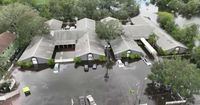As Tampa stands on the cusp of a sweeping transformation, the city is both looking forward and reflecting on its past. The demolition of Robles Park Village, the city’s oldest public housing complex, is set to begin on September 15, 2025, according to Tampa Bay Times. This marks the first step in an ambitious $800-million redevelopment plan that aims to reshape a 35-acre swath of central Tampa. But the story of Robles Park Village is about much more than bricks and mortar—it’s about history, resilience, and the enduring scars left by both human and natural forces.
Originally built in 1954, Robles Park Village was constructed to house some of Tampa’s poorest residents. Over the decades, it became not just a collection of buildings but a community, a place where generations grew up amid both hardship and hope. Yet, as the city has changed, so too have the needs of its residents. In 2024, city officials approved a new vision for the area, one that will transform it into a mixed-use affordable housing development designed for people of all income levels.
The redevelopment plan is as ambitious as it is sensitive. Not only will it replace aging housing stock with modern apartments, but it will also create a vibrant community hub. The vision includes educational and health care services, a grocery store, retail shops, walking trails, and—crucially—a memorial and genealogy center honoring Zion Cemetery, the city’s oldest African American burial ground. The presence of Zion Cemetery, long overlooked and even partially built over in the past, has brought a renewed sense of responsibility to the project. City leaders have pledged that the cemetery will be honored and preserved, ensuring that the stories of those buried there are not lost in the shuffle of progress.
“We’re not just building new homes,” said a city official, as reported by Tampa Bay Times. “We’re building a new future that acknowledges and respects the past.” The first phase of construction is scheduled to begin in April 2026, setting the stage for a years-long effort to remake the neighborhood while keeping its history alive.
But as bulldozers prepare to roll into Robles Park, Tampa and the surrounding region are still reeling from another set of challenges—ones delivered not by city planners, but by the forces of nature. In 2024, Florida’s west coast was battered by a series of powerful hurricanes, with Helene and Milton striking just weeks apart in September. According to a report by Action News Jax, the devastation was historic, with some areas experiencing the worst flooding in over a century.
Chief Meteorologist Mike Buresh of Action News Jax traveled the west coast in early 2025 to document the aftermath and the slow, painful process of recovery. His journey began in Cedar Key, a small fishing village on Florida’s Big Bend, which bore the brunt of storm surge and punishing winds. “Cedar Key was resilient but still in the process of what will be a long recovery,” Buresh observed, capturing the determination of a community unwilling to be defined by disaster.
Further south, near Tampa Bay, Treasure Island faced a one-two punch from Helene and Milton. The flooding there was described as the worst in more than 100 years, with homes and businesses gutted. Property owners were given stark choices: elevate their buildings to withstand future floods, or start over from scratch. The sense of loss was palpable, but so too was the resolve to rebuild.
Even inland neighborhoods weren’t spared. In Forest Hills, a suburb of Tampa not usually associated with severe flooding, disaster struck when a water pump generator failed during Hurricane Milton. The result was catastrophic—about 12 feet of water surged into the neighborhood, catching residents off guard and leaving a trail of destruction. “It took everyone by surprise,” Buresh reported, highlighting the unpredictable nature of modern storms and the vulnerabilities that can be exposed even far from the coast.
The stories of survival and recovery were featured in the First Alert Weather special, “Preparing for the Storm,” which aired in May 2025. Extended versions of these stories, including personal accounts from those affected, were made available online, offering a deeper look at the challenges Floridians now face with increasing regularity.
As Tampa prepares to break ground on its new master-planned community, the lessons of the past year loom large. The hurricanes of 2024 were a stark reminder that no part of the city is immune from the forces of nature. They also underscored the importance of resilient infrastructure and thoughtful planning—qualities that city leaders hope to embody in the Robles Park redevelopment.
The juxtaposition of demolition and renewal, of honoring history while preparing for an uncertain future, is not lost on residents. For some, the loss of Robles Park Village is bittersweet. “It’s hard to see it go,” said a longtime resident, reflecting on decades spent in the neighborhood. “But maybe it’s time for something new—something better for the next generation.”
The inclusion of Zion Cemetery in the redevelopment plans has been met with cautious optimism by descendants and community advocates. For years, the cemetery’s existence was neglected, its graves obscured by development and time. Now, with a dedicated memorial and genealogy center in the works, there is hope that the stories of those interred there will finally be given the recognition they deserve.
The broader context is inescapable: as climate change intensifies, cities like Tampa must grapple with both their histories and their futures. Affordable housing, disaster resilience, and historical preservation are not separate challenges—they are intertwined threads in the fabric of modern urban life. The $800-million investment in Robles Park is about more than new buildings; it’s about creating a community that can withstand the storms to come, both literal and metaphorical.
For now, the countdown to demolition continues. Residents, city officials, and advocates are working together to ensure that the transition is as smooth and respectful as possible. There are still many hurdles ahead—construction delays, funding questions, and the ever-present risk of another hurricane season. But there is also a sense of hope, a belief that Tampa can emerge stronger, more inclusive, and more resilient.
As the city prepares to say goodbye to Robles Park Village and welcome a new chapter, the lessons of the past—whether from the ravages of storms or the injustices of forgotten cemeteries—are shaping a vision for the future that is both ambitious and grounded in remembrance.




